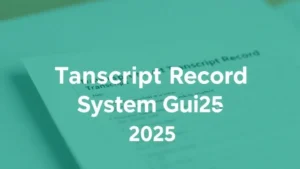University Transcript: What It Is & How to Get
You want clarity on your academic journey, right? Agree that tracking your courses and grades can feel like decoding a secret language. Well, here’s the promise: by the end of this guide, you’ll understand exactly what a university transcript is, why it matters (spoiler: it’s not just a sheet of paper), and how to request one without hair-pulling frustration. We’ll preview the definition, importance, request process, fees, delivery options, plus pro tips to avoid common mistakes. Easy. Clear. Human-friendly. Let’s dive in.
Did you know nearly 80% of institutions now use electronic transcripts for faster delivery?1 (Source: Uniacco.com)
Ready? Let’s roll.
Table of Contents
- What Is a University Transcript?
- Why Your University Transcript Matters
- How to Get Your University Transcript
- Transcript Formats, Fees & Delivery
- Future Trends in Transcript Requests
- FAQs about University Transcripts
- 1. Can I request multiple copies at once?
- 2. What if I need my transcript urgently?
- 3. Will my transcript show transferred credits?
- 4. Can I view my transcript online before ordering?
- 5. What if there’s an error on my transcript?
- Conclusion
What Is a University Transcript?
Here’s the thing: a transcript is more than a grade report. It’s your academic story.
In other words, a transcript is an official record that lists every course you’ve taken, the credits awarded, and your grades—chronologically. Unlike your diploma, which just confirms graduation, the transcript dives into details: semester by semester, course by course.
“Starting the transcript request process early is advisable, as delays can occur due to verification and processing requirements.”
– Uniacco.com, 2025
Interestingly enough, transcripts even note in-progress courses and remedial work, depending on your school’s policy. That’s why admissions officers, employers, and scholarship committees rely on them as the authoritative source.
Why Your University Transcript Matters
Ever wondered why people obsess over transcripts? Simple: they’re keys to your next opportunity.
Context: Whether you’re applying to a master’s program, vying for a competitive scholarship, or negotiating a job offer, stakeholders want proof of your academic performance. A transcript isn’t just proof; it’s a narrative of your learning journey.
Here’s what’s at stake:
- Graduate school eligibility
- Transfer credit validation
- Employment screening
- Professional certifications
Case in point: Jane, a chemistry major, thought her GPA would speak for itself. But when her prospective employer saw missing Fall 2023 grades (due to a financial hold), her job offer stalled. Lesson? Always verify holds are cleared before requesting a transcript.
How to Get Your University Transcript
Need a transcript? Follow these steps:
- Visit your registrar’s or academic records webpage.transcript-request-forms
- Fill out the official request form (online or paper).
- Prepare identification: government ID, student ID, or signed authorization letter.
- Pay applicable fees (electronic often cheaper; alumni may pay more).
- Submit your request and note the confirmation number.
- Track processing status via the portal or email notifications.
Processing times typically range from 7 to 14 days after submission (excluding weekends).2 If you’re in a pinch, some schools offer expedited or overnight services for an extra fee.
“Eligibility decisions will now rely solely on how repeat coursework is handled on the official transcript, emphasizing the transcript’s authoritative role.”
– NAIA Legislative Services, 2025
Let me explain: the NAIA removed repeat course regulations effective Fall 2026, so every repeated class appears unfiltered on the transcript.3 That’s why ensuring accuracy matters.
Transcript Formats, Fees & Delivery
Wondering about delivery methods? You have two main options: electronic and paper.
Electronic transcripts are fast, secure, and often free for current students. They use encryption and digital seals to prevent tampering. Conversely, paper transcripts arrive by mail and may include the registrar’s raised seal and signature.
Fee breakdown (average ranges):
- Electronic: $0–$10
- Paper (domestic): $5–$15
- Paper (international): $10–$25
Note: Some institutions waive fees for students with financial need or active alumni statuses. Always inquire about fee waivers.
Future Trends in Transcript Requests
Looking ahead, electronic transcripts are becoming the norm. Governments and institutions are adopting the eTranscript Data Standard for interoperability. Automation will further streamline requests: AI-based chatbots could handle routine queries by 2027. Security features—like blockchain verification—will also rise.
So, next time you request your transcript, you might just get a secure digital copy delivered to your smartphone. Cool, right?
- Transcript = official, detailed academic record.
- Essential for grad school, jobs, certifications.
- Request via registrar’s portal; expect 7–14 days.
- Electronic preferred for speed; paper still available.
FAQs about University Transcripts
1. Can I request multiple copies at once?
Yes. Most schools let you order several at a discounted bulk rate. Always specify the quantity on your request form.
2. What if I need my transcript urgently?
Inquire about expedited options. Fees vary, but you could get your transcript within 24–48 hours.
3. Will my transcript show transferred credits?
Absolutely. Transcripts list all transfer credits, often with the original institution’s course code and grade.
4. Can I view my transcript online before ordering?
Many universities provide an unofficial version in your student portal. It’s handy for quick checks but not acceptable for official submissions.
5. What if there’s an error on my transcript?
Contact your registrar ASAP. You may need to submit a grade change form or provide supporting documents (e.g., corrected grade report).
Conclusion
To sum up, the university transcript is your academic passport—detailing every course, grade, and credit you’ve earned. We covered what it is, why it’s critical, how to request it, and where trends are headed. Now it’s your turn to act:
- Visit your registrar’s portal today and download the request form.
- Clear any holds on your account before submitting.
- Choose the delivery method that fits your timeline—electronic for speed, paper for tradition.
Finish this now, and you’ll thank yourself later. Your future opportunities depend on a flawless transcript. Go get it!





